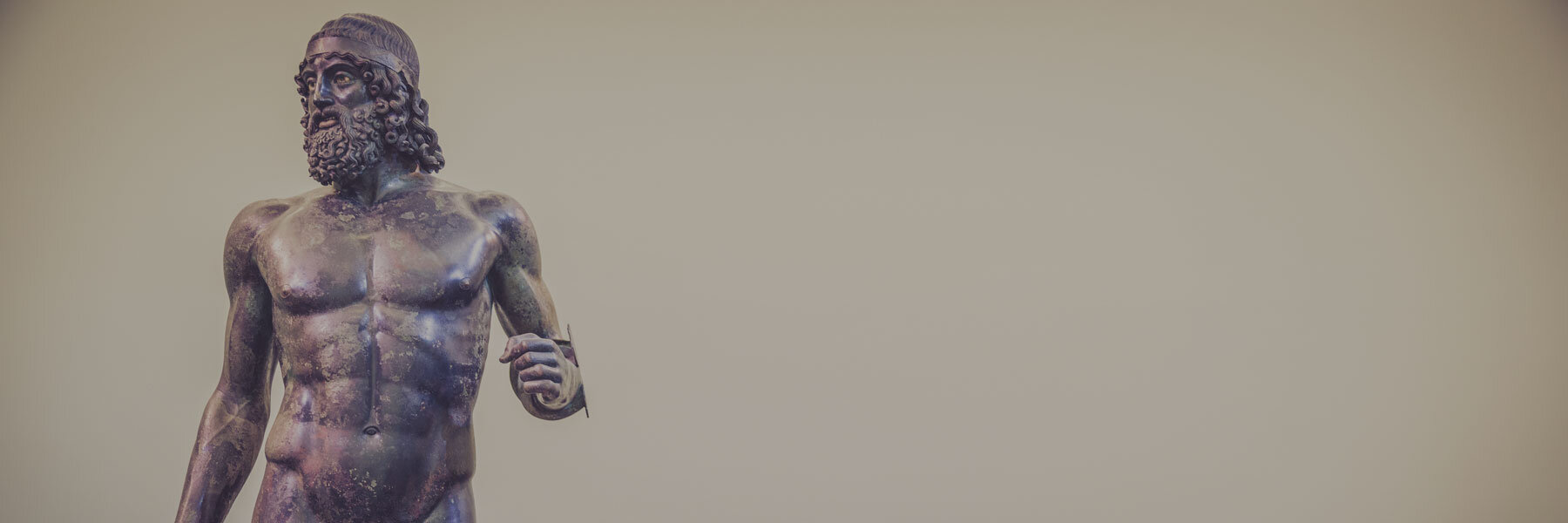What is a museum?
If we think about an archeological museum, sure we consider it something very similar to a gym. There is an instructor who guides you in understanding some problems.
You can improve your approach to analyze historical events. A museum is a place that gives you physical and spiritual well-being, thanks to an enthusiast, a passionate teacher that explains who we are and where we come from. Each tourist, every teenage student should visit a museum at least twice a year.
Reggio Calabria hosts one of the most beautiful archeological museums in the world.
Must Visit Reggio
Why is Reggio so important?
Because it allows you to discover the Riace Bronzes: in Reggio Calabria museum there are the two most famous bronze statues in the world.
That’s pride, that’s happiness to host this art treasure. A real privilege.
The archeological museum of Reggio Calabria
The wonderful findings exhibition in Reggio Calabria is at Palazzo Piacentini, tourist entrance in Piazza De Nava. Very easy to get to. You can park your car on the seafront or come comfortably by train to Reggio Calabria Lido station, the museum is right nearby, 200 meters away.
Museum is the happy result to put together the finds from the 19th century Civic Museum, and all the precious rarities emerged from the prodigious archeological excavations conducted in Calabria in the 20th century. Mostly in the 20th century some archeologists began the enormous work to search for the ancient foundations of Magna Graecia.
The archeologist Paolo Orsi
Paolo Orsi was the key figure.
One scientist coming from Northern Italy – «he needed South», he had a mission, a dream, the strong will to discover that unknown world. Paolo Orsi was a pioneer in the first decades of the last century, acting like a true detective 🕵🏼 . Nicely, for some of his tenacious and incredible research, we can consider him a Calabrian Indiana Jones.
He was the main government officer, he had to organize ‘Soprintendenza’ – the assigned authority to rescue and protect Cultural Heritage, to lead operations in archeological sites.
So he was a leader, he imagined the “home” of Magna Graecia, a big museum strictly focused on that impressive work done to investigate deep ground layers. That land kept the “body of evidence” of Greek colonies (and everything else!).
The remains of Magna Graecia in Calabria
First greek people immigration was in VIII century b.C. . The most epic challenge by Paolo Orsi was the excavation campaign conducted in Locri Epizephyirii, the ancient settlement founded by immigrants from Locride, a region of central Greece.
Locri in Calabria was a cultural hub, it influenced way of living in the classical society.
Zaleuco from Locri was a politician who inspired the first collection of laws and regulations in the western side of “Europe”. He wrote accurate rules to introduce civil guarantees for citizens – defining how justice had to work.
Must See:
the new design of Reggio Calabria archeological museum
MArRC now can offer a well-designed show, from second to ground floor. Experts have been brilliant to complete this particular fitting, they understood what was the best itinerary, following chronological steps and displaying thematic areas.
You should begin from prehistorical rooms, where some important files describe how was the hominids’ society before the Greeks appeared on the shore of the Ionian Sea.
The archeological areas in Calabria
On the first floor it’s important to linger over well-stocked showcases of cities and some sanctuaries in Magna Graecia: Sibari, Thurii, Crotone, Kaulon, Locri, Reggio and then the “spin-off” colonies situated on the Tyrrhenian Sea such as Hipponion and Medma.
The cult of Persephone
There are things giving a shocking beauty out, such as the votive ‘pinakes’ from the Sanctuary of Mannella in Locri: the pinax is a small square model, made in terracotta (baked clay), in the frame charming scenes with bas-reliefs related above all to the myth of Persephone.
Starting from the interpretation of these bas-relief scenes, we can reconstruct the rituals of the cult, how the Locresi used to pray in the sanctuary.
Greeks meet Italic clans
In the mezzanine floor, between the 1st and the ground floor, scholars did an in-depth investigation about the everyday life of Magna Graecia.
They analyzed new syntheses that were created after the fusion of Greek and Italic populations such as the Lucani and the Brettii.
The origin of Reggio Calabria
On the ground floor, the tourist can walk close to a series of finds illustrating the Greek and the Roman ages in Rhegion; impressive finds are from the Hellenistic necropolis (4th-2nd century BC) discovered during the construction of Palazzo Piacentini.
The Riace Bronzes
But it is quite understandable how, once you have reached the end of the museum path, visitor falls prey to a sort of frenzy, of electrifying impatience, because he knows…
Tourist knows that in that last room the most famous bronzes in the world await him!
The two large statues recovered from the Ionian seabed in Riace (between the towns of Monasterace and Roccella Jonica) are symbols of the historic grandeur of Calabria and, in general, of Southern Italy.
Since in the classical age this vast region of the Mediterranean was indeed a crossroads of cultures, commerce, knowledge, cradle of art and philosophy, a fertile and strategic land chosen by Greeks and Romans for their business.
The tip and heel of the Italian Boot were at the center of the world, watched and sought-after by all the countries who had economic interests in the Mediterranean basin.
A treasure settled on the seabed
We’re going to focus on specific reportages about the Riace Bronzes and about all the single wonders of the National Archaeological Museum of Reggio Calabria.
Think about the incredible pieces such as the bronzes and ceramics found inside the wreck of Porticello (Strait of Messina) – the Head of the Philosopher and the Head from Basilea are the “classmates” of the Riace warriors in the final hall.
What happened on August 16, 1972, an unforgettable day for Calabria
That lucky underwater sighting in Riace, dating back to 16 August 1972, was something epochal, which gave Calabria and Italy the chance to enjoy two bronze treasures of rare beauty.
The studies of numerous scientists and art historians are currently concentrated on the reconstructive hypotheses.
They are still doing studies on provenance, dating (V or IV century BC), on what they represented, on the technical ability to create them so divinely.

